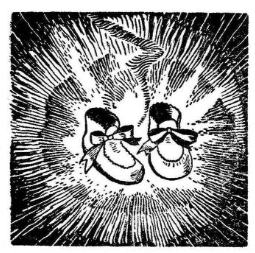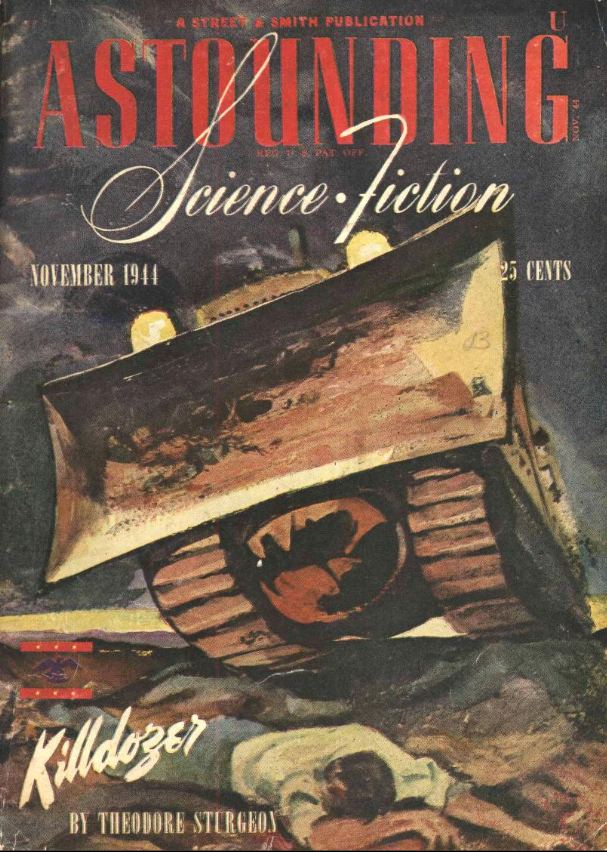
Been a while since we strained some pulp, but hey, here we are, charging once more unto the breach of some classic short stories. And this week we’ve got a great, complex, conflicted, and all around wonderful piece of fiction from one of the greatest pulps of all time, Astounding Science Fiction. It’s “When the Bough Breaks” from November 1944, by “Lewis Padgett” which, of course, was actually the pen name of the husband-and-wife team of Henry Kuttner and C.L. Moore.
Now, it’s no secret: Moore is one of my favorite writers of all time, and we’ve spent a lot of time with her on the ol’ blog here. She’s a tremendously powerful writer and hugely important to the history of genre fiction, a towering figure indeed. We haven’t talked much about ol’ Hank Kuttner, her husband (met through the letter writin’ circle of H.P. Lovecraft, by the way), and we’ll definitely have to change that, at some point – he was himself an interesting writer, with fun Sword & Sorcery and Lovecraftian horror stories to his name, but for my money his greatest work was done in collaboration with Moore, a process so seamless that the two of them would claim that, at the end of it all, neither could really tell who had written what in a finished story. That might be the case, although I feel like you can get a sense for the themes and styles and approaches each one brought to the stories – Kuttner has a flair for goofy humor, while Moore’s subtly and grasp of the uncanny always shines through. Regardless, the two of them had some kind of strange alchemy, since none of their work ever reads like a mash-up between two writers, a pretty amazing result, all things considered.
But, before we get into the story, let’s take a look at and REALLY APPRECIATE the cover art of this issue of Astounding! It’s KILLDOZER, and it’s fuckin’ great. The artist is William Timmins, one of the main pulp cover painters of the day – he was all over, and his style really evokes that 40s – 50s era pulp aesthetic, to me. Very “painterly,” but dynamic and energetic. I also love that “Killdozer” got the cover – it’s a great novella by another one of the truly great writers of the era, Theodore Sturgeon (who was, fyi, the inspiration for Vonnegut’s Kilgore Trout). We’ll definitely have to do some stuff by Sturgeon at some point – hugely influential figure.
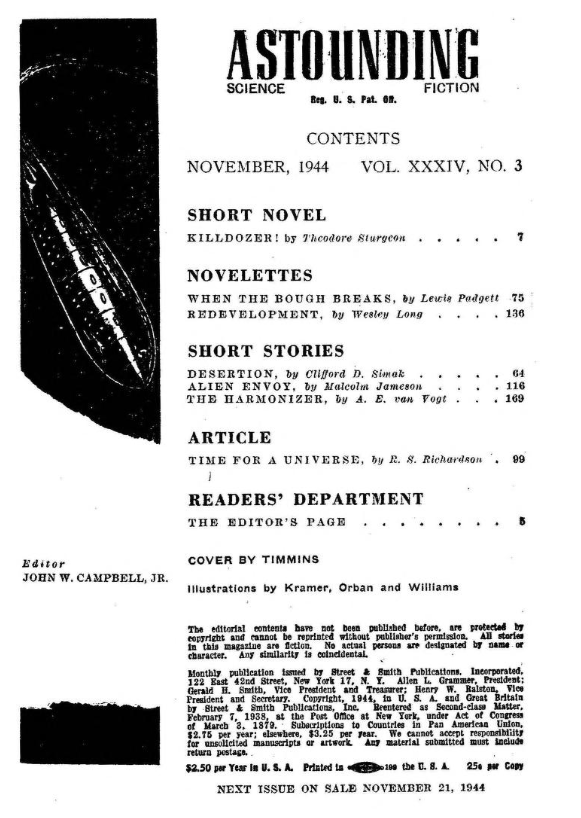
As always with Astounding, it’s a hell of a ToC this issue: Sturgeon, “Padgett,” Simak, van Vogt…titans all! Malcom Jameson and Wesley Long are less well known today, although at the time both were well-known luminaries in the sci-fi world. Jameson was famous for his navy-influenced space operas and left his imprint on military and ship-focused science fiction, while Long is one of the pseudonyms used by George O. Smith, famous for his hard sci-fi “Venus Equilateral” stories (a fun series about a communications station at the L4 Lagrange of the Sun-Venus system) AS WELL AS having his wife leave him for the editor of Astounding, John W. Campbell, Jr. Astounding at this time really was the preeminent science fiction magazine, a remarkable archive of the “Golden Age” of that genre.
But, anyway, on to the story!

Now, based on the art and summary, you might be inclined to skip this story. The art is good, don’t get me wrong; credited to “Williams” in the annoying surname-only style affected by Astounding, it’s almost certainly Arthur Williams, one of the stable of usual artists used by the magazine (and that’s almost all I know about him, too). It’s a fun, clean style, and here he gets to embrace a certain cartoony flair for the little weird goblin-men (that we’ll meet soon). But, goddammit, a baby konking a weird little dude in the eye just doesn’t seem to promise much, does it?
The summary is the culprit real here, though – “super-baby” is absolutely a red flag, a warning that you might be in store for one of those fuckin’ hyuck-hyuck cutesy cornball stories that are just so awful. If you, like me, listen to a lot of Old Time Radio, you know exactly what I’m talking about – the show Dimension X, which adapted stories from Astounding Science Fiction, was perversely fond of the “humorous” stories that appeared in its pages, often about exasperated everymen confronting the madness of the push-button era. They’re almost always often firmly entrenched in what Joanna Russ called the “Galactic Suburbia” too, a kind of broad assumption by a lot of writers of the era that the standard white, middle-american nuclear family was as inevitable and immutable as gravity. Execrable, teeth-grinding stuff.
Now, there’re two reasons why you should persevere here, despite the warning signs of the art and the summary we’ve just talked about. First off: this story is from 1944, and the really egregious examples of glib “Galactic Suburbia” shit don’t show up until the post-war boom really starts to take off, mostly in the 50s. Secondly, and more importantly, this is “Lewis Padgett” we’re talking about, and anything associated with C.L. Moore, a master of thoughtful subversion, is absolutely worth your time! So let’s dive in!
The first paragraphs of the story introduce to two young parents, Joe and Myra Calderon. Joe is a physicist at a nearby University, and Myra is his ever-lovin’ red-haired housewife. The two of them have, through extraordinary luck, been able to get an apartment in the city, despite the crushing housing crisis (that would, in real life, soon get worse after the war, leaving an indelible mark on the literature of that era). Their luck seems to arise from this particular apartment:

Weird figures have been showing up to “4-D” (a pun you’ll soon get) at all hours, apparently looking for someone. Odd! But, moving right along, we’re soon introduced to the third member of the Calderon family, Alexander:

A very normal baby, to all appearances, although we know better from the story summary above. Joe and Myra engage in some expository banter, well-written and with a warmth that, I think, speaks to the easiness that C.L. Moore and Henry Kuttner must’ve had with one another in their own life. They talk briefly about the need for a nurse or a maid, focusing our attention on the hard labor that goes into raising a kid. And then:

Four weird little dudes show up at the Calderon’s door, claiming to be the descendants of Alexander Calderon from the future. It’s an odd scene, to be sure, and comes with a funny lil illustration and everything:
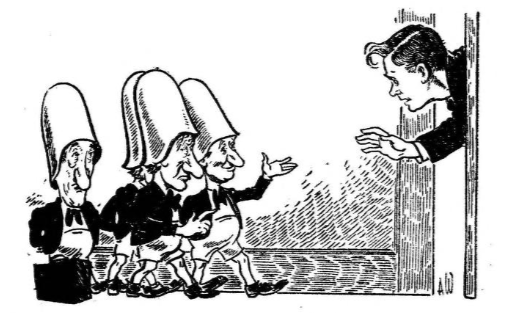
The little guys scurry into the room, evading Joe’s attempts to stop them, and gather reverently around baby Alexander, using the strange and exotic verbiage of an unknown superscience to describe attributes of his development and skull shape and potential. Alarmed and confused, the parents demand an explanation from the apparent leader of the tiny gang, Bordent.
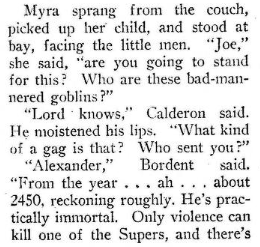
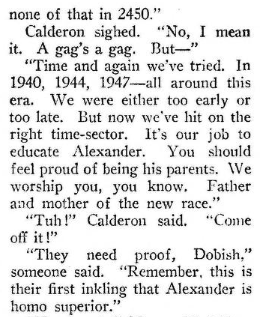
So, some 500+ years in the future, Alexander, then a fully mature superbeing, sends this four little guys back into the past in order to give himself a developmental boost via educational methods as a baby. These four little guys represent the future of humanity, a species now dominated genetically by their descent from these “homo superior” specimens.
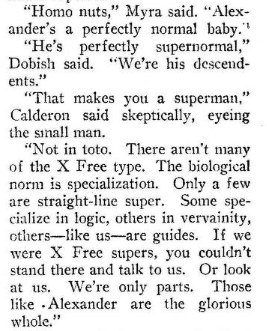
So, that’s a pretty chilling statement there at the end, isn’t it. These little guys aren’t anything like the true Homo superior that Alexander is – if they were, the Calderon’s couldn’t “stand there and talk” to them, or even look at them. You could, at this point in the story, interpret that to mean some kind of transcendence on the part of future-Alexander and his super-ilk – like, they’re literally noncorporeal or something. What we’ll learn in the story is that it’s likely much more sinister, however. It’s also interesting to see that Alexander is, apparently, an “X Free type” or an “X Free super;” kind of neat to see both “homo superior” and “X” as a specific genetic aspect used here, isn’t it? Future influence on Marvel comic aside, there’s also a fascinating bit of history of science/history of medicine going on here, with Moore and Kuttner clearly aware of then current work being done on mutations and sex-linked inheritance of traits.
Of course, in the story, Joe and Myra tell this little goblins to fuck off – there’s no way you’d ever believe a story like that, even if a tiny huge-headed weirdo told it to you. In order to convince them, the little guys use their ultratech to paralyze the Calderons. One of the little guys then pries the baby free from Myra’s grasp and, promising that they’re not going to hurt him, they begin “instructing” him:


Following the lesson, the little guys leave, un-freezing the parents as they do. Aghast, the two parents try and cope with the obviously strange situation and their relative powerlessness.
The next day, in an attempt to evade the little weirdos, they take Alexander out to a movie. However, in the middle of the picture, Alexander simply vanishes. They search the aisle, hoping that they just dropped him, but they both know the score soon enough – they decide that he’s obviously been grabbed by the little guys, and that he’s probably back at their apartment. They hurry on over, and sure enough:

Bordent menaces them with paralyzation, but the Calderons promise to behave – it’s evident that they’re going to have to adapt to this new situation.
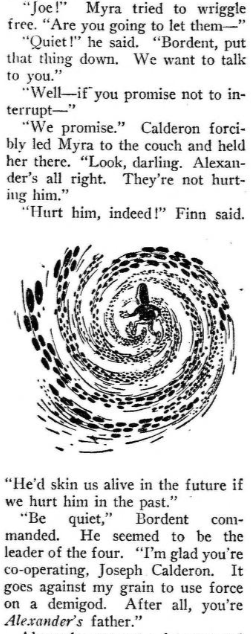
Again, there’s a *hint* of some darkness here, with the future Alexander apparently capable of instilling a healthy fear in his underlings. The Calderons watch Alexander going through his lessons, babbling happily while weird devices execute strange programs designed to enhance a superbaby’s development. There’s weird lights and sounds and technical jargon, but the little guys seem pleased enough with his progress. But, of course, Alexander is STILL a baby:
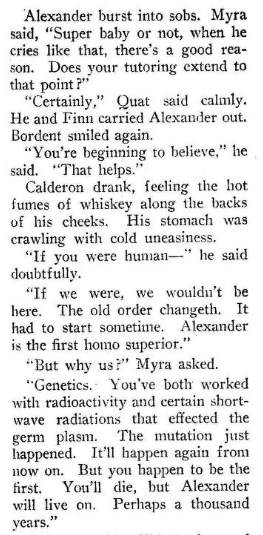
An interesting insight into just how much the genetic revolution and the Modern Synthesis in biology had permeated (albeit imperfectly) into pop culture of the time – exposure to the byproducts of modernity have influenced the Calderon’s genetics, resulting in the first of what will, inevitably, be more mutants born to the human race. Of similar impact is the revolution in psychology as well, because the story immediately begins to talk about the importance of childhood development:

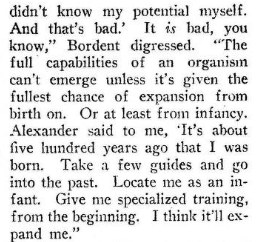
It’s interesting to get this glimpse of two of the big changes in parenting that came about in the mid-20th century: a concern about environmental impacts on reproduction AND a technocratic interest in the “right” way to enrich a child (and, especially, a baby) for optimal results. Myra, the mother, wants to know what this means for their family:
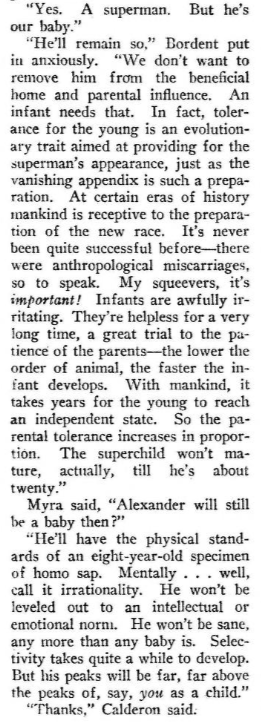
A lot to unpack here in the long section quoted above. First off all, the idea that tolerating a baby, which are by nature extremely irritating entities, is an aspect of human evolution is a lot of fun. Babies ARE a pain, and there’s got to be a mechanism, social or biological or some combination of the two, that prevents parents from throttling the yowling, smelly little things. What Bordent is saying here is that the next step in human evolution had to wait around for this tolerance mechanism to develop sufficiently, because if regular babies are aggravating, superbabies are more so!
Secondly, there’s a VERY interesting thing going on in the last bit of the quoted section, where Bordent is explaining that Alexander is going to be, basically, a child, at least until he’s around twenty or so. We’ll come back to this point at the end, but keep it in mind – the question of what is developmentally “normal” (or, perhaps…”typical?”) for children is being raised here, and it’s a large part of the story. Like I said, we’ll talk about it later.
This discussion of Alexander’s future development is curtailed when Alexander starts acting like a baby again:

Luckily, Alexander is distracted by something, and Quat gets to keep his eyeball in his socket. The lessons done for the day, the Calderons spend the evening getting drunk and trying to wrestle with the world they’ve been introduced to.
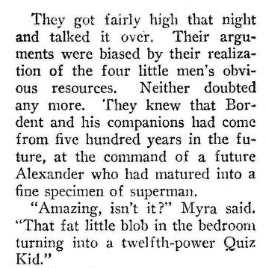
I just wanna highlight the “Quiz Kid” reference there, because its an interesting glimpse into the prevalence of “kid geniuses” in the popular culture at the time. “Quiz Kids” was a radio (and later, TV) show that had a rotating panel of child “prodigies” who answered esoteric questions about various arcane subjects, a kind of genteel freak show/kids-say-the-darndest-thing/game show. It’s a really fascinating piece of popular culture, and was hugely influential at the time; you see references to it all the time if you’re reading magazines or books from the era. There’s also an absolutely amazing memoir/biography/personal history graphic novel by artist/writer/comics god Michael Kupperman about his father, Joel Kupperman, one of the more famous of the Quiz Kids from the era. It’s called “All the Answers” and it’s really an incredible book. Click that link and, seriously, get yourself a copy, it’s great.
The daily super-education lessons continue, and over the next week they start to bear fruit:
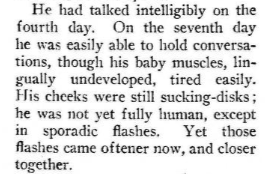
Joe is watching his son bustling around among the futuristic learning toys that have been left in their house, waiting for the arrival of the four little weirdos for their daily edification session. He’s nursing a highball and considering how strange his child has become, obviously contemplating how much farther he has to go.
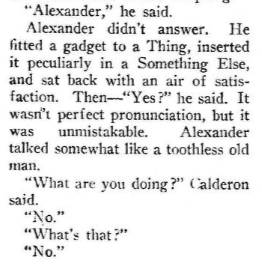
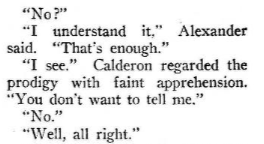
Pausing here, let’s consider this exchange. On the face of it, it’s evident that this superbaby is, basically, becoming disdainful of his merely-mortal parents. But what struck me when reading this is the repeated “No,” which reminded me of Donald Triplett who in 1943 (a year before this story came out), was the very first person ever diagnosed as autistic. As a child, he would often only give “yes” or “no” answers, regardless of the question, and often used “no” as a means of shutting down a conversation or line of questioning. The doctor who worked with Triplett was Leo Kanner, considered one of the founders of modern child psychiatry whose work on childhood brains and development was of substantial interest in the wider popular culture of the time. There’s no direct proof, but it’s hard to imagine this story being written without Kanner’s work being part of the larger conversation around children at the time. In particular, Kanner’s identification of childhood autism and his description of its symptoms, seems to be a large part of the background of this story, as we’ll see.
In the meantime, Alexander becomes harder to deal with. He decides to test his digestive system by puking wildly all over the place, tersely demanding his mother clean it up once he’s done. He decides he wants to understand his lung capacity and vocal abilities more, so he institutes a regime of nonstop screaming all day and night. As his lessons continue his powers likewise expand, and with it, his demands.
On the one hand, these are generally just the demands of a baby, right? I mean, babies DO make a mess, shitting and puking all over the place, and a parent DOES have to clean up after them. Similarly, babies cry! Babies want things they can’t have! They have tantrums! What makes them troubling, though, is that Alexander is not merely an irrational baby – he’s a super baby, and his hungers and desires and rages are all expressed in English (and, of course, backed up with super powers). There’s certainly as aspect of weirdness-for-weirdness sake here, at work here, but it also stands in for concerns and uneasiness about parenting and children. And of course, it’s also very hard to NOT read this story in the light of our modern day, contemporary discussions of autism and neurodivergence and parenting.
Alexander’s lessons continue, and in the light of his past behaviors, Calderon raises the subject of discipline.

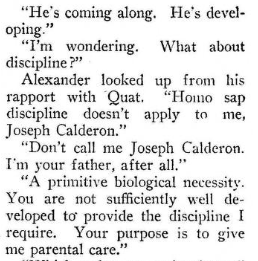
Bordent tries to assuage Joe and Myra’s concerns, explaining that, as a super being, Alexander requires very different kinds of discipline, and that they cannot provide it. They must simply be patient and tolerant of their super child. And then, there’s some foreshadowing:
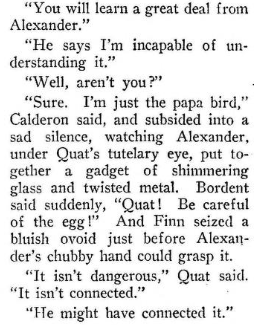
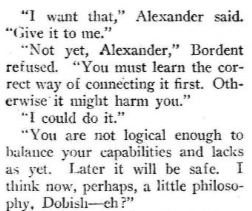
I’m sure THAT’LL never come up again.
Moving on, Alexander’s powers continue to develop – he flaunts his intellectual superiority at ever turn, happily pumping his parents for information and then using his advanced brain to make complex, intuitive leaps that leave them in the dust. And that’s not all. One day he wants candy, and when his mother tells him she doesn’t have any he simply teleports her to the candy store. Later, for his own amusement, he electrically shocks his mother and father, just to see their dumb faces when they fall down. The Calderons try again to talk to the four little guys, but they’re just pleased that Alexander is advancing so quickly.


Bordent makes it very clear that the Calderons are not going to be allowed to discipline Alexander – they will protect him, at all costs, and if that means incapacitating his semi-divine parents, well, so be it.
Two months pass, and Alexander continues to develop his powers, and life continues to become less and less tolerable for his parents. The shocks, the random teleportation, the constant demands, and Alexander’s cruel sense of humor are making things very difficult for Joe and Myra. Joe is unable to do his work at the University, and Myra is clearly getting worn down from taking care of Alexander during the day.


Interesting to see the use of the word “autistic” there; like I said above, there’re clear finger prints of the complexification of peoples’ understanding of childhood development all over this story.
The Calderons are being pushed to the edge by their superbaby – both of the parents are wrecks, sleep-deprived and harried by the constant demands of their superbaby. And it’s about to get worse – Bordent informs them that a great milestone has been reached! Alexander will no longer need to sleep! Instead, he’ll be active 24 hours a day, advancing that much faster now that the biological weakness of fatigue has been surpassed. Dumb with horror, the parents can accept their fate as the caretakers of this little monster.
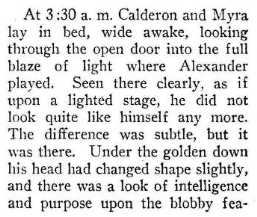

Alexander has a sudden tantrum, scattering his crystals, screaming in rage, using his mind powers to make the windows slam. The phone rings, and Joe is informed that, because of the constant noise and bother, they’re being evicted. By this point, however, both Myra and Joe are numb to the outside world; they’re prisoners of their superbaby, and they’re reaching a breaking point. They talk about how they’re supposed to do this, how anybody could do it, and they again wonder if anybody else ever has…HAS there been a superbaby before? There couldn’t have been, right? I mean, they’d have HEARD about it…right?
Alexander demands milk (warm, not hot this time, dammit!) and Joe rises to serve him. When he returns, he finds Myra deep in thought.
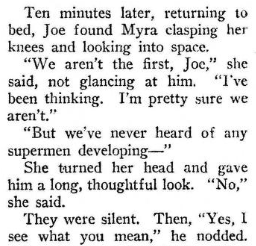
I mean, wow, right? Straight up veiled discussions of fuckin’ infanticide right there in the pages of Astounding Science Fiction from 1944. Wild stuff! But it gets at what this story is mostly about – the delicate, dangerous balancing act of “tolerance” needed to care for a baby.
Joe and Myra are distracted from their dark train of thought by a crash from the living room, followed by the sounds of splintering wood and Alexander’s cruel chuckling. And then:

The blue egg! Remember that? Who could’ve foreseen that it would come back again!? Still, I’ll just reproduce the whole final page, because it’s pretty amazing and, honestly, kind of moving.

From a writing stand point, that’s some remarkably economical prose, isn’t it? I mean, look how much Moore and Kuttner convey with just a few choice verbs and some dialog. Joe’s mention of the future gets Myra on the same page very quickly, and then their self-justification that, well, maybe we should let him burn himself, so he learns a lesson…it’s all so good, eliding the real conversation that they’re having. And then, of course, the fuckin’ super baby kills itself, which is WILD; it’s definitely NOT one of those cutesy “family” sci fi stories you might’ve been worried about, is it? It’s also followed by a genuinely conflicted (and very much a C.L. Moore-ean) scene of sadness and resignation at the very end, with Myra and Joe’s silent little interaction communicating a particular poignancy.
The time travel stuff is a little odd at the end – I mean, it’s a classic paradox, right? It doesn’t really matter, but I hope Joe and Myra don’t have to answer TOO many questions from the cops about where their baby got to…of course, it’s 1944 and they’ve just been evicted, so I’m sure they can just start over again somewhere else without Detective Joe Friday hounding them or anything.
More interestingly, from our perspective today it’s hard not to read “autism” onto this story, and that’s not entirely incorrect, I think – this story is about complex and difficult childhood development, and the strains parents face. The details of autism, and our understanding of it today, are of course different and much deeper, but even without that specific diagnostic modality there’s lots of evidence that Moore and Kuttner were interested in atypical childhood development in this work. And, importantly, there’s lots in the text showing that questions about childhood psychology, environmental effects on reproduction, the functioning of families under stress, are all at the topics of interest for American culture in the 40s. That makes it a VERY dark story, of course; overwhelmed by the task of parenting an “abnormal” baby, Joe and Myra basically murder Alexander, their son, through a very deliberate act of neglect. That’s grim shit!
I think it’s also trying to explore the particularly insidious societal expectations around parenting, too; like the assumption that OF COURSE you want your baby – the constant refrains from Bordent about how Joe and Myra are genetically predisposed towards “tolerance” of their child sounds very similar to the assumption that parents MUST (and of course WILL) love their children unconditionally. It’s all part of a very pervasive (and corrosive) assumption about life roles too, isn’t it? That the highest calling is parenting a precious baby that must, at all costs, become the center of the universe for you. I mentioned Russ’s “Galactic Suburbia” earlier – this story presciently seems to be right there with her, arguing against the oppressive, pervasive heteronormativity that Russ had identified as being foundational to a lot of the (bad) sci fi of the 50s and 60s.
More broadly, I think it’s also a part of Moore’s interrogation of love as a destructive force. In “Shambleau” and “Black God’s Kiss” we saw how interested she is in the idea of love as a dangerous and sometimes deadly impulse. Of course, as a collaboration between Moore and Kuttner, it’s not ALL just C.L. doin’ the writin’ and whatnot, but she’s definitely shown an interest in that line, more so than anything I’ve seen in Kuttner’s work.
All in all, I think it’s a provocative, interesting, and (most importantly) good piece of science fiction, one that shows how remarkable Moore and Kuttner’s partnership was!

